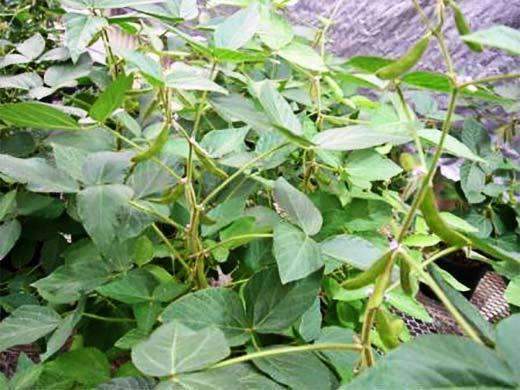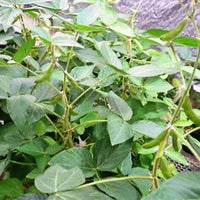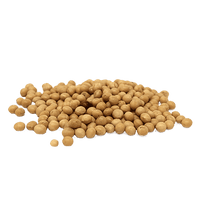
- When to plant:
- Spring, Summer
- Fertilizer:
- Varies
- Seeding rate:
- 1 lb. per 1,000 sq.feet or 35 - 45 lbs. per acre
- Overseeding rate:
- Not Applicable
- Seeding depth:
- 1/2 - 1 inch
- Ideal ph:
- 5.5 - 6.5
- Gmo:
- Yes
- Inoculant needed:
- S Type Inoculant - Soybeans
- Coated or raw:
- Raw
- Lifecycle:
- Annual
- Climate zones:
- Cool Season, Transition Zone, Warm Season
Soybeans are excellent for mixing with Dwarf Corn, Grain Sorghum, Peas, Millet, Alyce Clover and many other food plot seeds. Osage Soybeans is in maturity group 5.
Product Information
- Application or Use: Food Plot, Cover Crop
- Germination Time: 5 - 7 days, under optimal conditions
- Growing Locations: Warm Season, Transition Zone, Cool Season
- Height: 3 - 5 feet
- Sunlight Requirements: 8+ hours, full sun for best results
- Advantages: Traditional forage soybean, excellent for mixing with corn, sorghum, peas, millet, etc. for food plots.
- When to Plant: Recommended planting time is spring and summer when night time temperatures are consistently 65+ degrees.
Product Detail
- Round Up Ready
- Forage Variety
- Annual legume
- Food plots for wildlife
- Fast growing
- Works well with other seeds
Product Information
Soybeans are an annual legume that is planted in food plots for deer, ducks, dove, quail and other wildlife. Soybeans need to be inoculated with S type inoculant. Soybeans are an annual plant, which may vary in growth habit and height.
*Product packaging may appear different than what is pictured.
Plant between April and August at a rate of 35 to 45 lbs. per acre. Plant at a depth of 1/2 to 1 in. Test soil to find a pH of 5.5 to 6.5. Use S Type Inoculant.
When choosing to start a new lawn, remove old vegetation by using a de-thatcher, power rake or tiller to kill the existing vegetation. Rake or drag the area to remove debris and dead grass for a clean area. Ensure the soil is leveled and loosened to allow the seed to have good soil contact once spread on a clean seed bed.
If you have an area with heavy weed coverage, we recommend starting fresh by killing and removing the existing vegetation. If you choose to use chemicals, herbicides or fertilizers, you must check with the product's manufacturer prior to planting new seed to ensure the proper waiting period.
When overseeding an existing area, mow your lawn at the lowest setting and bag the clippingsx. Rake or drag any areas that have dead thatch or debris.

Seed Quality
Hancock Seed is dedicated to delivering the best seeds possible to our customers. Hancock Seed grows and harvests many of our products, and we acquire the majority of the rest from other family farmers.
All these seeds are processed, packaged and shipped from Hancock Farm. This helps us ensure that our high standards are met. Unlike much of the competition, we refuse to sell you a seed that was not gathered during the last harvest. You will always receive fresh product from Hancock.
Every seed we grow comes with 40 years of experience behind it...you can rest assured that all of our products are cultivated in a method that assures its potential for growth.

Your cart ( 0 )

Soybeans are excellent for mixing with Dwarf Corn, Grain Sorghum, Peas, Millet, Alyce Clover and many other food plot seeds. Osage Soybeans is in maturity group 5.
Product Information
- Application or Use: Food Plot, Cover Crop
- Germination Time: 5 - 7 days, under optimal conditions
- Growing Locations: Warm Season, Transition Zone, Cool Season
- Height: 3 - 5 feet
- Sunlight Requirements: 8+ hours, full sun for best results
- Advantages: Traditional forage soybean, excellent for mixing with corn, sorghum, peas, millet, etc. for food plots.
- When to Plant: Recommended planting time is spring and summer when night time temperatures are consistently 65+ degrees.
Product Detail
- Round Up Ready
- Forage Variety
- Annual legume
- Food plots for wildlife
- Fast growing
- Works well with other seeds
Product Information
Soybeans are an annual legume that is planted in food plots for deer, ducks, dove, quail and other wildlife. Soybeans need to be inoculated with S type inoculant. Soybeans are an annual plant, which may vary in growth habit and height.
*Product packaging may appear different than what is pictured.
Plant between April and August at a rate of 35 to 45 lbs. per acre. Plant at a depth of 1/2 to 1 in. Test soil to find a pH of 5.5 to 6.5. Use S Type Inoculant.
Instructions
When choosing to start a new lawn, remove old vegetation by using a de-thatcher, power rake or tiller to kill the existing vegetation. Rake or drag the area to remove debris and dead grass for a clean area. Ensure the soil is leveled and loosened to allow the seed to have good soil contact once spread on a clean seed bed.
If you have an area with heavy weed coverage, we recommend starting fresh by killing and removing the existing vegetation. If you choose to use chemicals, herbicides or fertilizers, you must check with the product's manufacturer prior to planting new seed to ensure the proper waiting period.
When overseeding an existing area, mow your lawn at the lowest setting and bag the clippingsx. Rake or drag any areas that have dead thatch or debris.


















